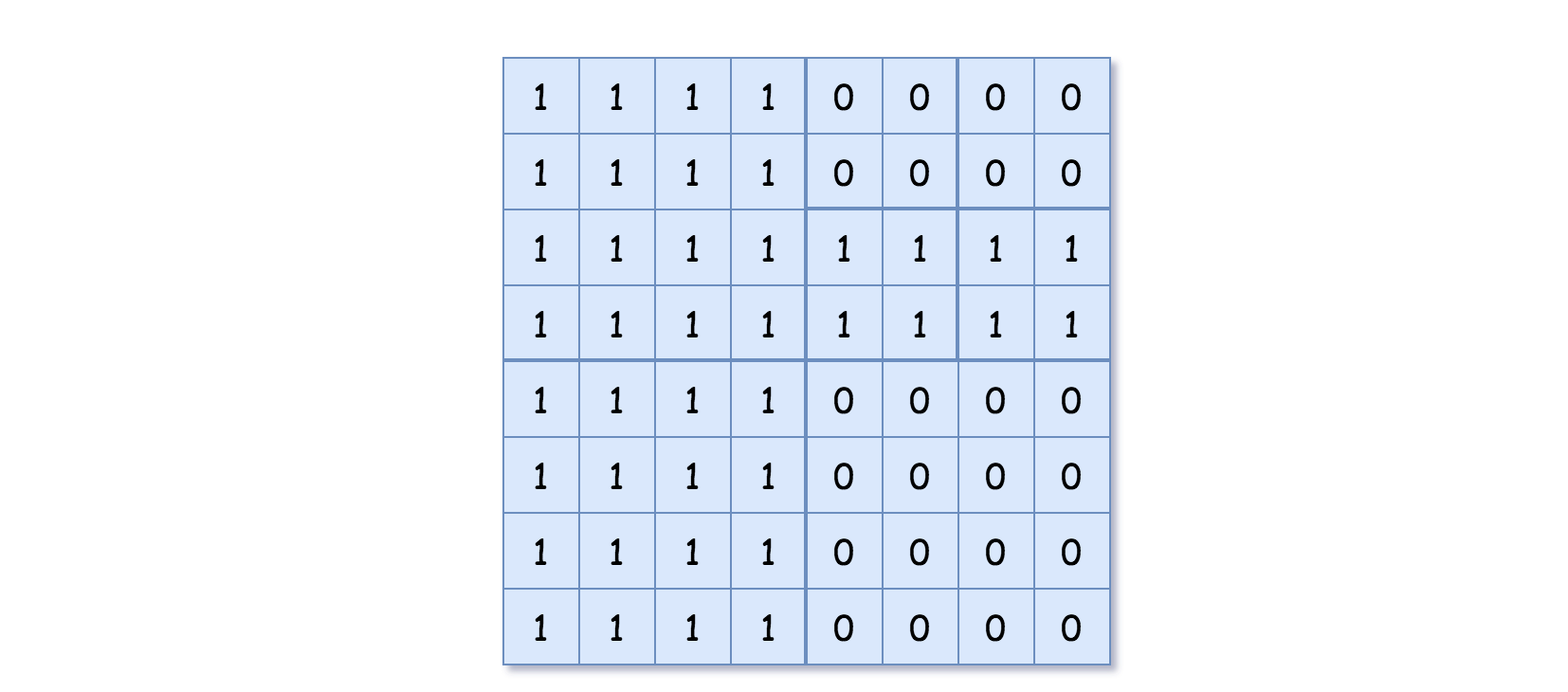2021-01-01 Daily-Challenge
HAPPY NEW YEAR!
Today I have done Construct Quad Tree on leetcode and leetcode's January LeetCoding Challenge with cpp.
Construct Quad Tree
Description
Given a n * n matrix grid of 0's and 1's only. We want to represent the grid with a Quad-Tree.
Return the root of the Quad-Tree representing the grid.
Notice that you can assign the value of a node to True or False when isLeaf is False, and both are accepted in the answer.
A Quad-Tree is a tree data structure in which each internal node has exactly four children. Besides, each node has two attributes:
val: True if the node represents a grid of 1's or False if the node represents a grid of 0's.isLeaf: True if the node is leaf node on the tree or False if the node has the four children.
class Node {
public boolean val;
public boolean isLeaf;
public Node topLeft;
public Node topRight;
public Node bottomLeft;
public Node bottomRight;
}
We can construct a Quad-Tree from a two-dimensional area using the following steps:
- If the current grid has the same value (i.e all
1'sor all0's) setisLeafTrue and setvalto the value of the grid and set the four children to Null and stop. - If the current grid has different values, set
isLeafto False and setvalto any value and divide the current grid into four sub-grids as shown in the photo. - Recurse for each of the children with the proper sub-grid.

If you want to know more about the Quad-Tree, you can refer to the wiki.
Quad-Tree format:
The output represents the serialized format of a Quad-Tree using level order traversal, where null signifies a path terminator where no node exists below.
It is very similar to the serialization of the binary tree. The only difference is that the node is represented as a list [isLeaf, val].
If the value of isLeaf or val is True we represent it as 1 in the list [isLeaf, val] and if the value of isLeaf or val is False we represent it as 0.
Example 1:

Input: grid = [[0,1],[1,0]]
Output: [[0,1],[1,0],[1,1],[1,1],[1,0]]
Explanation: The explanation of this example is shown below:
Notice that 0 represnts False and 1 represents True in the photo representing the Quad-Tree.
Example 2:

Input: grid = [[1,1,1,1,0,0,0,0],[1,1,1,1,0,0,0,0],[1,1,1,1,1,1,1,1],[1,1,1,1,1,1,1,1],[1,1,1,1,0,0,0,0],[1,1,1,1,0,0,0,0],[1,1,1,1,0,0,0,0],[1,1,1,1,0,0,0,0]]
Output: [[0,1],[1,1],[0,1],[1,1],[1,0],null,null,null,null,[1,0],[1,0],[1,1],[1,1]]
Explanation: All values in the grid are not the same. We divide the grid into four sub-grids.
The topLeft, bottomLeft and bottomRight each has the same value.
The topRight have different values so we divide it into 4 sub-grids where each has the same value.
Explanation is shown in the photo below:
Example 3:
Input: grid = [[1,1],[1,1]]
Output: [[1,1]]
Example 4:
Input: grid = [[0]]
Output: [[1,0]]
Example 5:
Input: grid = [[1,1,0,0],[1,1,0,0],[0,0,1,1],[0,0,1,1]]
Output: [[0,1],[1,1],[1,0],[1,0],[1,1]]
Constraints:
n == grid.length == grid[i].lengthn == 2^xwhere0 <= x <= 6
Solution
class Solution {
Node* construct(vector<vector<int>>& grid, int left, int top, int size) {
int one = 0;
for(int i = 0; i < size; ++i) {
for(int j = 0; j < size; ++j) {
one += grid[top+i][left+j];
}
}
if(one == 0 || one == size*size) return new Node(one, true);
int newSize = size/2;
Node *topLeft = construct(grid, left, top, newSize);
Node *topRight = construct(grid, left+newSize, top, newSize);
Node *bottomLeft = construct(grid, left, top+newSize, newSize);
Node *bottomRight = construct(grid, left+newSize, top+newSize, newSize);
return new Node(0, false, topLeft, topRight, bottomLeft, bottomRight);
}
public:
Node* construct(vector<vector<int>>& grid) {
int size = grid.size();
return construct(grid, 0, 0, size);
}
};
January LeetCoding Challenge 1
Description
Check Array Formation Through Concatenation
You are given an array of distinct integers arr and an array of integer arrays pieces, where the integers in pieces are distinct. Your goal is to form arr by concatenating the arrays in pieces in any order. However, you are not allowed to reorder the integers in each array pieces[i].
Return true if it is possible to form the array arr from pieces. Otherwise, return false.
Example 1:
Input: arr = [85], pieces = [[85]]
Output: true
Example 2:
Input: arr = [15,88], pieces = [[88],[15]]
Output: true
Explanation: Concatenate [15] then [88]
Example 3:
Input: arr = [49,18,16], pieces = [[16,18,49]]
Output: false
Explanation: Even though the numbers match, we cannot reorder pieces[0].
Example 4:
Input: arr = [91,4,64,78], pieces = [[78],[4,64],[91]]
Output: true
Explanation: Concatenate [91] then [4,64] then [78]
Example 5:
Input: arr = [1,3,5,7], pieces = [[2,4,6,8]]
Output: false
Constraints:
1 <= pieces.length <= arr.length <= 100sum(pieces[i].length) == arr.length1 <= pieces[i].length <= arr.length1 <= arr[i], pieces[i][j] <= 100- The integers in
arrare distinct. - The integers in
piecesare distinct (i.e., If we flatten pieces in a 1D array, all the integers in this array are distinct).
Solution
last two constraints is important.
class Solution {
public:
bool canFormArray(vector<int>& arr, vector<vector<int>>& pieces) {
unordered_map<int, int> pos;
int len = arr.size();
for(int i = 0; i < len; ++i) {
pos[arr[i]] = i;
}
for(auto &piece : pieces) {
int curPos = -1, len = piece.size();
for(int i = 0; i < len; ++i) {
if(!pos.count(piece[i]) || (curPos != -1 && pos[piece[i]] != curPos + 1)) return false;
curPos = pos[piece[i]];
}
}
return true;
}
};